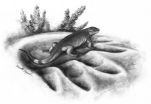(Press-News.org) A team of scientists led by Johns Hopkins and Stanford University researchers has laid the groundwork for understanding how variations in immune responses to Lyme disease can contribute to the many different outcomes of this bacterial infection seen in individual patients. A report on the work appears online April 16 in PLOS One.
"Physicians have recognized for many years that Lyme disease is not a uniform disease process and can vary in outcomes," says Mark Soloski, Ph.D., a professor of medicine at the Johns Hopkins University School of Medicine and senior author of the report. "Our experiments have linked such differences to specific immune pathways controlled by elements of the immune system, which in turn might help us understand both the good immune processes that clear up the infection and the bad ones that cause injury and prolong symptoms. This could be a big step forward in managing this disease."
Lyme disease is caused by the bacterium Borrelia burgdorferi, which is transmitted to humans through the bite of infected ticks. The U.S. Centers for Disease Control and Prevention estimates that there are 300,000 new cases of Lyme disease a year. Symptoms can include fever, headache, fatigue and a characteristic circular, red skin rash called erythema migrans, which occurs early in the disease.
Arthritis, nervous system abnormalities and heart rhythm abnormalities can appear weeks or months after infection.
Although treatment with antibiotics usually restores pre-infection health within a few weeks, some patients develop post-treatment Lyme disease syndrome, whose symptoms include fatigue, pain or joint and muscle aches that can last for several months. The exact cause is not well understood, and the symptoms are difficult to treat, the researchers say.
In a bid to identify why symptoms persist in some patients and not others, the Johns Hopkins team searched for the biological "signature" of the early stages of Lyme disease by measuring the levels of immune system molecules, called cytokines, chemokines and acute phase makers — proteins released by the liver as part of the process of inflammation. These molecules, which are also called mediators, orchestrate the complex interactions of the immune system response to infection, including inflammation.
Specifically, the team studied levels of 58 cytokines and chemokines plus seven acute phase markers in blood from 44 patients diagnosed with Lyme disease and 23 healthy people used as controls for comparison.
The team's analysis identified two subsets of Lyme disease in patients in the acute (early) stage of infection — "mediator-high" and "mediator-low."
The levels of three chemokines in particular — CXCL9, CXCL10 and CCL19 — were increased in the mediator-high group and returned to normal levels after antibiotic treatment and the disappearance of the rash. Chemokines are small signaling molecules that attach to specific sites, called receptors, on a certain type of immune cells. These three chemokines in particular guide a type of immune cell called T lymphocytes into tissues to aid in the clearance of infection. The movement of T cells from the bloodstream to the site of infection also contributes to inflammation, which can cause tissue injury, Soloski notes. There was also an increase in the acute phase proteins released by the liver, including CRP and serum amyloid A.
Lyme disease patients displaying high mediator levels at the initial pretreatment visit (acute disease) also had more severe symptoms, higher rates of bacterial antibody production, greater rates of elevated liver enzymes and low blood lymphocytes levels. Elevated levels of liver enzyme activity are common during infection and other diseases and may indicate that the liver is a site of infection during human Lyme disease.
Individuals in the mediator-low group appear to represent Lyme disease patients who failed to mount a vigorous immune response, the researchers reported.
The results of the study indicate that the levels of chemokines in the blood and the levels of their specific receptors on the T cells they stimulate might prove to be important biomarkers for Lyme disease, and they could be linked to specific symptoms of the disease, Soloski says. Biomarkers are biological characteristics or molecules whose levels in the body or tissues can be measured to identify a specific biological state or condition (e.g., disease or response to therapy).
Although the study wasn't specifically designed to learn about post-treatment Lyme disease syndrome, the authors speculate that the variations in the pattern of mediators they observed strongly influence whether particular patients will recover from Lyme disease or develop long-term post-treatment symptoms.
"This study gives us basic data that will help us look for evidence of prolonged inflammation after completion of therapy and might, in the long term, help us identify biomarkers that predict that a particular person will develop post-treatment Lyme disease syndrome," Soloski says. "And since the chemokines that were elevated are key to the movement of T cells, blocking them might prevent them from moving into tissues and prolonging inflammation. This is one of the long-term aims of our work."
INFORMATION:
John N. Aucott, M.D., of Johns Hopkins also contributed to the research, as well as researchers from the Lyme Disease Research Foundation and the Stanford University School of Medicine.
Research reported in this publication was supported by the National Institutes of Health's National Institute of Arthritis and Musculoskeletal and Skin Diseases (P30AR05350), the Donald B. and Dorothy L. Stabler Foundation, the Lyme Research Alliance, the Lyme Disease Research Foundation and the Brennan family.
Johns Hopkins Medicine (JHM), headquartered in Baltimore, Maryland, is a $6.7 billion integrated global health enterprise and one of the leading health care systems in the United States. JHM unites physicians and scientists of the Johns Hopkins University School of Medicine with the organizations, health professionals and facilities of The Johns Hopkins Hospital and Health System. JHM's vision, "Together, we will deliver the promise of medicine," is supported by its mission to improve the health of the community and the world by setting the standard of excellence in medical education, research and clinical care. Diverse and inclusive, JHM educates medical students, scientists, health care professionals and the public; conducts biomedical research; and provides patient-centered medicine to prevent, diagnose and treat human illness. JHM operates six academic and community hospitals, four suburban health care and surgery centers, and more than 30 primary health care outpatient sites. The Johns Hopkins Hospital, opened in 1889, was ranked number one in the nation for 21 years in a row by U.S. News & World Report.
Research may help doctors predict who gets long-term complications from Lyme disease
Findings may advance efforts to better manage the infection
2014-04-17
ELSE PRESS RELEASES FROM THIS DATE:
Off-season doesn't allow brain to recover from football hits, study says
2014-04-17
Six months off may not be long enough for the brains of football players to completely heal after a single season, putting them at even greater risk of head injury the next season.
"I don't want to be an alarmist, but this is something to be concerned about," said Jeffrey J. Bazarian, M.D., associate professor of Emergency Medicine at the University of Rochester School of Medicine and Dentistry and lead author of the study, published in PLOS ONE.
"At this point we don't know the implications, but there is a valid concern that six months of no-contact rest may not be enough ...
Earliest ancestor of land herbivores discovered
2014-04-17
New research from the University of Toronto Mississauga demonstrates how carnivores transitioned into herbivores for the first time on land.
"The evolution of herbivory was revolutionary to life on land because it meant terrestrial vertebrates could directly access the vast resources provided by terrestrial plants," says paleontologist Robert Reisz, a professor in the Department of Biology. "These herbivores in turn became a major food resource for large land predators."
Previously unknown, the 300-million-year old fossilized juvenile skeleton of Eocasea martini is ...
Banning chocolate milk backfires
2014-04-17
ITHACA, N.Y. – To some, banning chocolate milk from elementary schools seemed like a good idea, but new Cornell University research shows that removing chocolate milk from school menus has negative consequences.
"When schools ban chocolate milk, we found it usually backfires. On average, milk sales drop by 10 percent, 29 percent of white milk gets thrown out, and participation in the school lunch program may also decrease," reports Andrew Hanks, lead author and research associate Cornell's Dyson School of Applied Economics and Management. "This is probably not what parents ...
Researchers see hospitalization records as additional tool
2014-04-17
MEDFORD/SOMERVILLE, Mass. – Comparing hospitalization records with data reported to local boards of health presents a more accurate way to monitor how well communities track disease outbreaks, according to a paper published April 16 in the journal PLOS ONE by a research team led by Elena Naumova, Ph.D., professor of civil and environmental engineering and associate dean at Tufts University School of Engineering.
In a paper titled "Hospitalization Records as a Tool for Evaluating Performance of Food and Water-Borne Disease Surveillance Systems: A Massachusetts Case Study," ...
The surprising consequences of banning chocolate milk
2014-04-17
VIDEO:
Director of the Cornell Food and Brand Lab, Brian Wansink recommends, "There are other ways to encourage kids to select white milk without banning the chocolate. Make white milk appear...
Click here for more information.
For many children eating school lunch, chocolate milk is a favorite choice. What would happen if chocolate milk were banned from school cafeterias? "Students take 10% less milk, waste 29% more and may even stop eating school meals," says Andrew Hanks, ...
Family ties in the language jungle
2014-04-17
This news release is available in German. The only linguistic data available for Carabayo, a language spoken by an indigenous group that lives in voluntary isolation, is a set of about 50 words. This list was compiled in 1969 during a brief encounter with one Carabayo family. Frank Seifart of the Max Planck Institute for Evolutionary Anthropology in Leipzig, Germany, and Juan Alvaro Echeverri of the Universidad Nacional de Colombia in Leticia, Colombia, have now analysed this historical data set and compared it with various languages (once) spoken in the region. The ...
High disease load reduces mortality of children
2014-04-17
This news release is available in German. Children who have been conceived during a severe epidemic are more resistant against other pathogens later in life. For the first time this has been proved by researchers at the Max Planck Institute for Demographic Research (MPIDR) in Rostock, Germany, for the 18th century epidemics of measles and smallpox in the Canadian province of Québec. Children who were conceived during the wave of measles in 1714 and 1715 died significantly less often from smallpox 15 years later than children who had been conceived before the measles ...
Declining catch rates in Caribbean green turtle fishery may be result of overfishing
2014-04-17
A 20-year assessment of Nicaragua's legal, artisanal green sea turtle fishery has uncovered a stark reality: greatly reduced overall catch rates of turtles in what may have become an unsustainable take, according to conservation scientists from the Wildlife Conservation Society and University of Florida.
During the research period, conservation scientists estimated that more than 170,000 green turtles were killed between 1991 and 2011, with catch rates peaking in 1997 and 2002 and declining steeply after 2008, likely resulting from over-fishing. The trend in catch rates, ...
In old age, lack of emotion and interest may signal your brain is shrinking
2014-04-16
MINNEAPOLIS – Older people who have apathy but not depression may have smaller brain volumes than those without apathy, according to a new study published in the April 16, 2014, online issue of Neurology®, the medical journal of the American Academy of Neurology. Apathy is a lack of interest or emotion.
"Just as signs of memory loss may signal brain changes related to brain disease, apathy may indicate underlying changes," said Lenore J. Launer, PhD, with the National Institute on Aging at the National Institutes of Health (NIH) in Bethesda, MD, and a member of the American ...
Dermatologists with access to sample drugs write costlier prescriptions, Stanford study finds
2014-04-16
STANFORD, Calif. — Dermatologists with access to free drug samples are more likely than those without access to samples to write prescriptions for drugs that are more expensive, according to a study by researchers at the Stanford University School of Medicine.
Although studies have shown that most physicians do not believe that the availability of free samples affects their behavior or recommendations for patients, the researchers found that the average retail cost of the prescriptions written by dermatologists with access to samples are about twice the cost of prescriptions ...
LAST 30 PRESS RELEASES:
Pre-school health programme does not improve children’s diet or physical activity, prompting call for policy changes, study finds
Autumn clock change linked to reduction in certain health conditions
AI images of doctors can exaggerate and reinforce existing stereotypes
Where medicine meets melody – how lullabies help babies and parents in intensive care
We may never be able to tell if AI becomes conscious, argues philosopher
AI video translation shows promise but humans still hold the edge
Deep ocean earthquakes drive Southern Ocean’s massive phytoplankton blooms, study finds
Without campus leftovers to pick through, the beaks of this bird changed shape during the pandemic
High-dose antibiotic does not reduce mortality in tuberculous meningitis
How many insects fly in the sky above the USA?
Could cheese protect your brain health?
Who faces more difficulty recovering from stroke?
Colliding galaxies create the brightest, fastest growing black holes at their center
New BrainHealth research reveals tradeoffs on sleep with cannabis use for chronic pain
Aging-US now on ResearchGate, enhancing visibility for authors and readers
'Molecular glue' stabilizes protein that inhibits development of non-small cell lung cancer
Mount Sinai Health System is recognized in 2025 Chime Digital Health Most Wired survey
From prey to predator: How carnivores spread beneficial fungi
Menopause symptoms may be frequent and have negative effects, according to female endurance athletes
US Congressmembers’ responses on X to mass shooting events differ along party lines
KAIST-UEL team develops “origami” airless wheel to explore lunar caves
Individual genetic differences render some therapies ineffective
Engineering dendritic cells boosts cancer immunotherapy
Sophisticated neuroimaging reveals PTSD in WTC responders is linked to measurable physical changes in brain structure
Health policy experts identify promising strategies for providing health care to homeless people
Study explores role of neutrophils in canine atopic dermatitis
Mayo Clinic researchers develop AI-ECG model to diagnose liver disease earlier
Heavy menstruation common among teenage girls – questionnaire reveals risk of iron deficiency
New study explores why open water swimming feels so powerful for midlife women
In echo of Jurassic Park, mosquitoes capture entire ecosystems in their blood meals
[Press-News.org] Research may help doctors predict who gets long-term complications from Lyme diseaseFindings may advance efforts to better manage the infection



